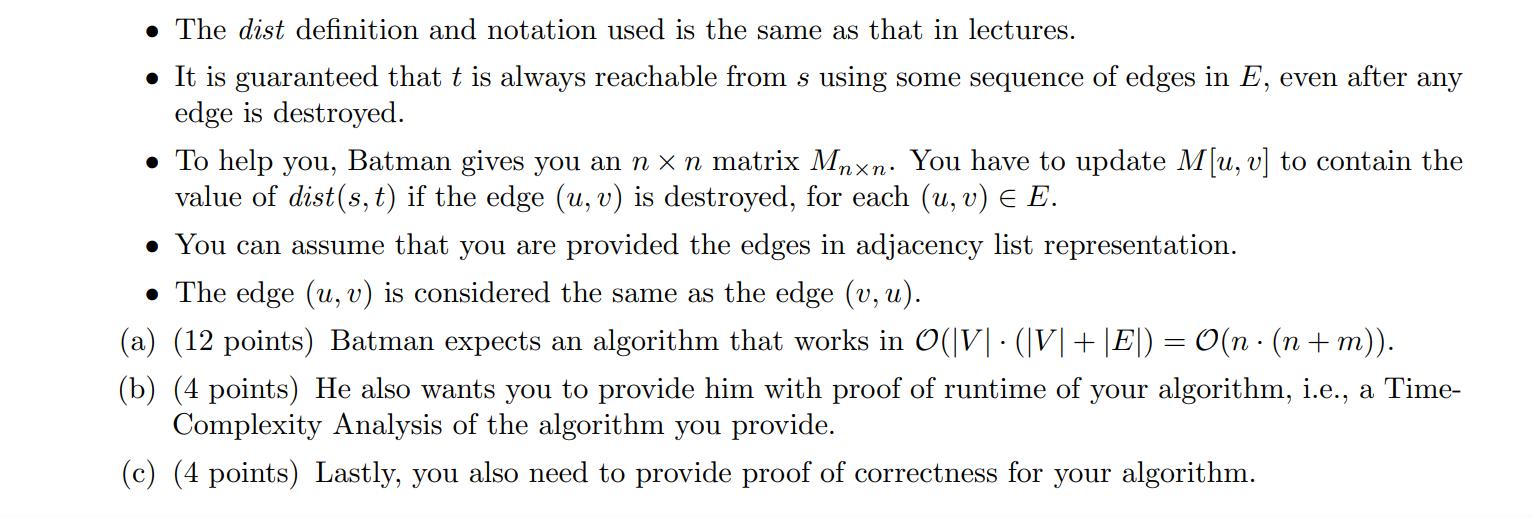Answered step by step
Verified Expert Solution
Question
1 Approved Answer
- Batman gives you an undirected, unweighted, connected graph G = (V, E) with |V| = n, |E| = m, and two vertices s,


- Batman gives you an undirected, unweighted, connected graph G = (V, E) with |V| = n, |E| = m, and two vertices s, te V. He wants to know dist(s, t) given that the edge (u, v) is destroyed, for each edge (u, v) E. In other words, for each (u, v) E, he wants to know the distance between s and t in the graph G' = (V', E'), where E' E\{(u, v)}. Some constraints: = The dist definition and notation used is the same as that in lectures. It is guaranteed that t is always reachable from s using some sequence of edges in E, even after any edge is destroyed. To help you, Batman gives you an n x n matrix Mnxn. You have to update M[u, v] to contain the value of dist (s, t) if the edge (u, v) is destroyed, for each (u, v) E E. You can assume that you are provided the edges in adjacency list representation. The edge (u, v) is considered the same as the edge (v, u). (a) (12 points) Batman expects an algorithm that works in O(V| (|V| + |E|) = O(n (n + m)). (b) (4 points) He also wants you to provide him with proof of runtime of your algorithm, i.e., a Time- Complexity Analysis of the algorithm you provide. (c) (4 points) Lastly, you also need to provide proof of correctness for your algorithm. - Batman gives you an undirected, unweighted, connected graph G = (V, E) with |V| = n, |E| = m, and two vertices s, te V. He wants to know dist(s, t) given that the edge (u, v) is destroyed, for each edge (u, v) E. In other words, for each (u, v) E, he wants to know the distance between s and t in the graph G' = (V', E'), where E' E\{(u, v)}. Some constraints: = The dist definition and notation used is the same as that in lectures. It is guaranteed that t is always reachable from s using some sequence of edges in E, even after any edge is destroyed. To help you, Batman gives you an n x n matrix Maxn. You have to update M[u, v] to contain the value of dist (s, t) if the edge (u, v) is destroyed, for each (u, v) E E. You can assume that you are provided the edges in adjacency list representation. The edge (u, v) is considered the same as the edge (v, u). (a) (12 points) Batman expects an algorithm that works in O(V| (|V| + |E|) = O(n (n + m)). (b) (4 points) He also wants you to provide him with proof of runtime of your algorithm, i.e., a Time- Complexity Analysis of the algorithm you provide. (c) (4 points) Lastly, you also need to provide proof of correctness for your algorithm. - Batman gives you an undirected, unweighted, connected graph G = (V, E) with |V| = n, |E| = m, and two vertices s, te V. He wants to know dist(s, t) given that the edge (u, v) is destroyed, for each edge (u, v) E. In other words, for each (u, v) E, he wants to know the distance between s and t in the graph G' = (V', E'), where E' E\{(u, v)}. Some constraints: = The dist definition and notation used is the same as that in lectures. It is guaranteed that t is always reachable from s using some sequence of edges in E, even after any edge is destroyed. To help you, Batman gives you an n x n matrix Mnxn. You have to update M[u, v] to contain the value of dist (s, t) if the edge (u, v) is destroyed, for each (u, v) E E. You can assume that you are provided the edges in adjacency list representation. The edge (u, v) is considered the same as the edge (v, u). (a) (12 points) Batman expects an algorithm that works in O(V| (|V| + |E|) = O(n (n + m)). (b) (4 points) He also wants you to provide him with proof of runtime of your algorithm, i.e., a Time- Complexity Analysis of the algorithm you provide. (c) (4 points) Lastly, you also need to provide proof of correctness for your algorithm.
Step by Step Solution
★★★★★
3.44 Rating (151 Votes )
There are 3 Steps involved in it
Step: 1
To solve this problem we can use Dijkstras algorithm to find the shortest path between s and t in the original graph G However since we need to comput...
Get Instant Access to Expert-Tailored Solutions
See step-by-step solutions with expert insights and AI powered tools for academic success
Step: 2

Step: 3

Ace Your Homework with AI
Get the answers you need in no time with our AI-driven, step-by-step assistance
Get Started


